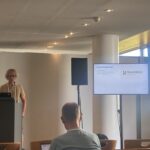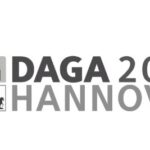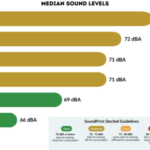In modern open-plan offices, noise from conversations and background activities can significantly impact employees’ productivity and well-being. Active noise-cancelling (ANC) headphones are often employed as a personal solution to reduce distractions and control the acoustic environment. But how effective are these devices in enhancing performance, reducing stress, or improving the overall work experience? This article […]
Various
Irrelevant speech makes perceived workload higher
Irrelevant speech, or background conversations, has been shown to impair cognitive performance and cause physiological stress. Recently published research demonstrated that working during task-irrelevant speech not only increases stress, as measured by heart rate variability, and reduces accuracy but also increases annoyance and perceived workload. Method Thirty participants performed two cognitive tasks (n-back and serial […]
Three strategies towards greater sustainability – presentation at DAGA conference
The 50th Annual Congress of the German Acoustical Society (DAGA) was held in Hannover this year. Celebrating decades of innovation and scientific advancement, DAGA 2024 featured presentations dedicated to sustainable practices in acoustic research and technology. This article provides a summary of the presentation by Achim Klein from Ecophon Saint-Gobain on the efficiency, consistency, and […]
After a full 50 years, Slovakia has a new acoustic standard!
Slovakia has a new STN 73 0527 acoustic standard that can finally improve conditions in schools! The new updated STN 73 0527 acoustic standard deals with room acoustics. In schools, universities, and spaces used for cultural, sports, social and public purposes. It aims at ensuring better quality and healthier acoustic conditions. New acoustic standard highlights […]
Improving acoustic comfort in swimming pools
Insights from Jeroen Vugts and Pien Schravesande at EAS 2024 Swimming pools, with their lively and dynamic environments, present unique acoustic challenges that are often overlooked. At the recent Ecophon Acoustic Seminar (EAS) in the Netherlands, ir. Jeroen Vugts and Pien Schravesande of LBP Sight presented an insightful discussion on the critical role of acoustics […]
BNAM 2024: A step forward in acoustic innovation
Baltic-Nordic Acoustic Meeting (BNAM) 2024 is leading the way in acoustic innovation in the Nordic countries. This year, BNAM has been exploring new ways to distinguish itself among major acoustic conferences like Internoise and Forum Acusticum. One of the key strategies has been to offer not just ordinary presentations but also hands-on workshops with software […]
Baltic-Nordic Acoustic Meeting 2024, Healthcare
On May 22-24, some 175 delegates from 18 countries gathered together in the beautiful venue at the Finnish-Swedish Cultural Center Hanaholmen. Located at the scenic seafront between Helsinki and Espoo in Finland. This second article will highlight the acoustic meeting presentations regarding Healthcare. Acoustics and Healthcare Acoustic comfort assessment in hospital wards: measuring procedures and […]
Baltic-Nordic Acoustic Meeting 2024
On May 22-24, some 175 delegates from 18 countries gathered together in the beautiful venue at the Finnish-Swedish Cultural Center Hanaholmen. Located at the scenic seafront between Helsinki and Espoo in Finland. Three days of conference targeted even more than before to the people practising acoustics every day. This meant that one of the Baltic-Nordic […]
Coffee chain premises noise data gathered by Soundprint
This interesting noise survey can help inform those looking for coffee chain premises which are most conducive for a good conversation. Crowdsourced data has been gathered by the pioneering Soundprint in the USA via their Soundprint App measuring the sound levels when customers visit with the App activated. Rolling data can inform consumer sound preferences […]
The relationship between acoustic privacy, personality type and burnout
The relationship between personality traits and burnout has been researched extensively. The current study conducted among UK office workers uniquely aimed to investigate the relationship between acoustic privacy, personality type and burnout. Although the link between acoustic privacy and burnout is less clear, the evidence shows that acoustic privacy affects stress levels, distractions, the ability […]











